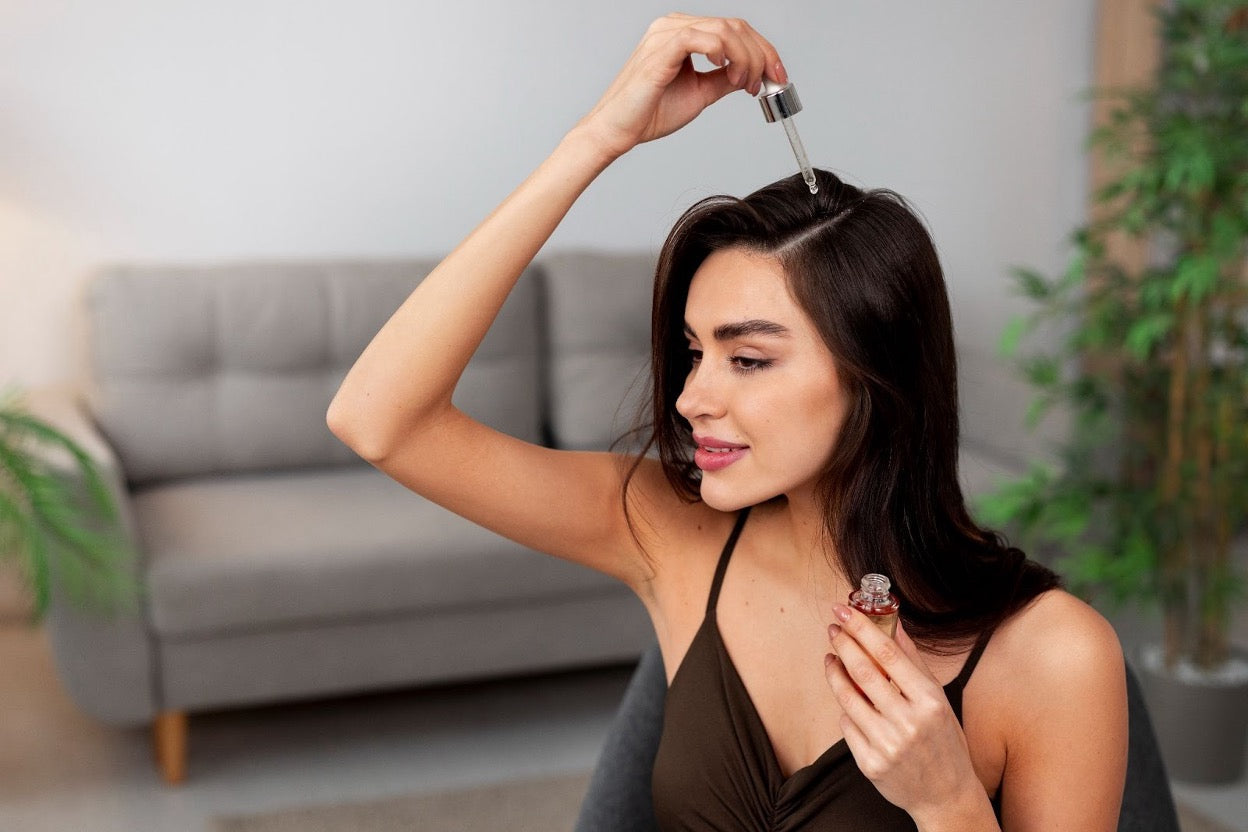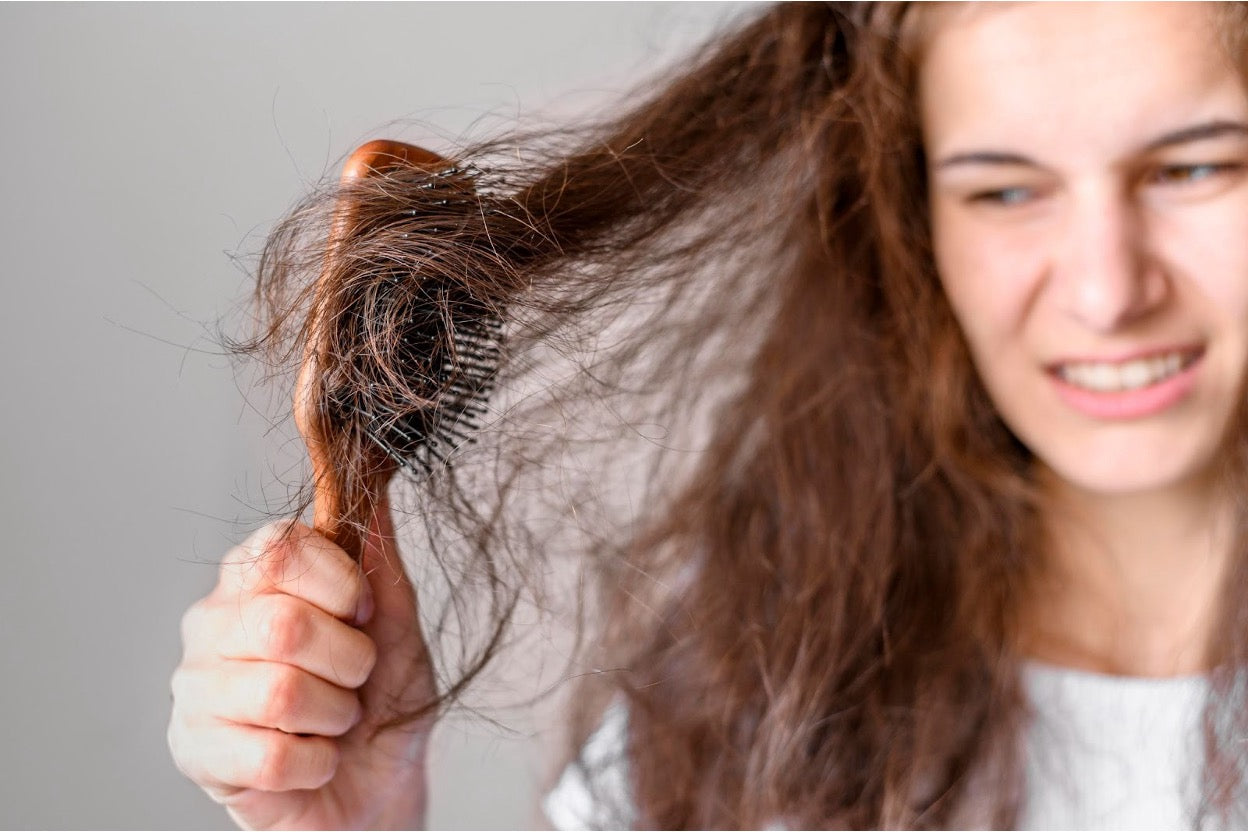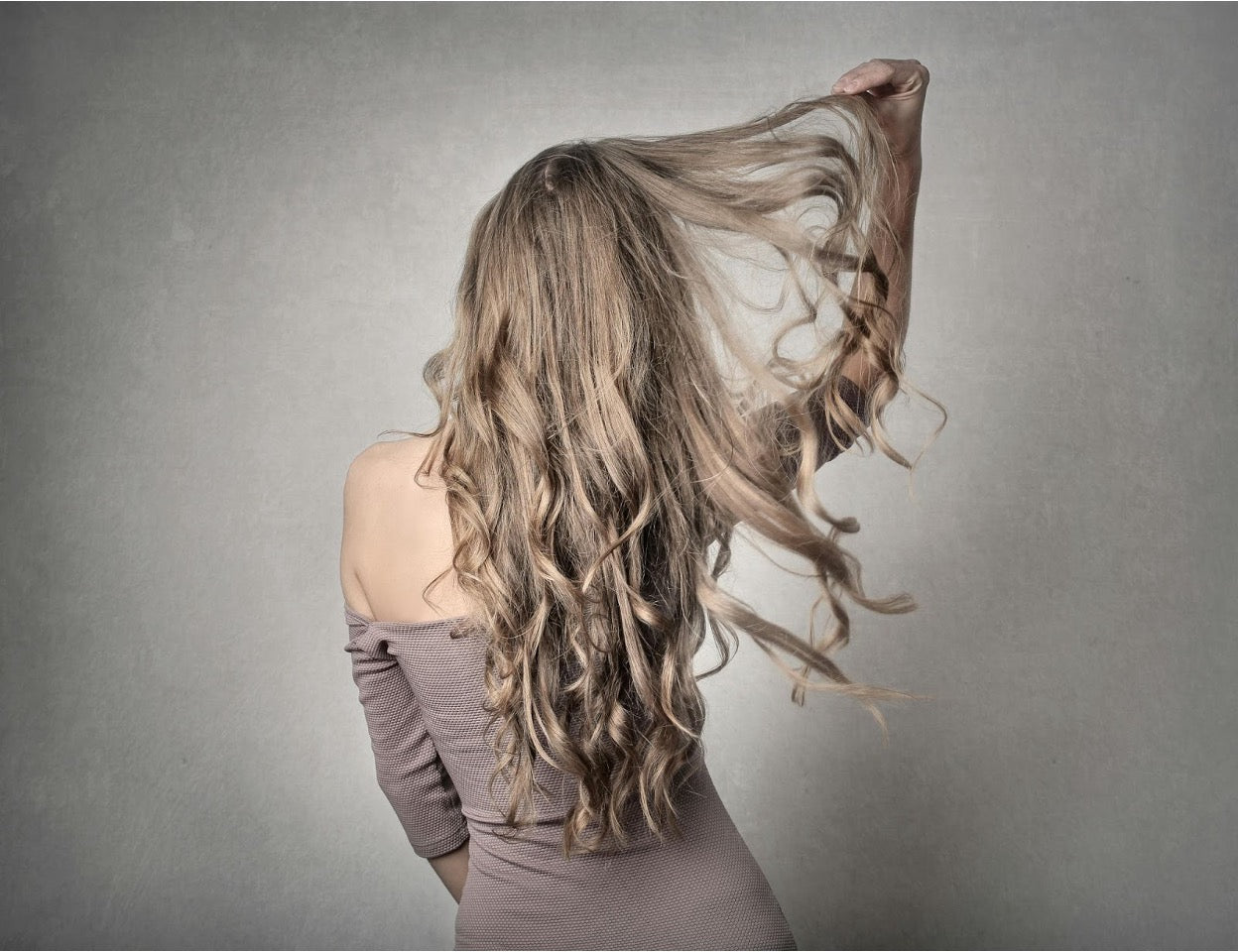Scalp Psoriasis vs Folliculitis: Causes, Differences & Treatment
BY TRYBELLO
Oct 31, 2025

Key Takeaways
- Scalp psoriasis is a disorder of the immune system that causes red, scaly patches, while folliculitis is a hair follicle infection that results in tiny pustules.
- Psoriasis requires long-term inflammation management, while folliculitis generally responds well to antibacterial treatments.
- Correct diagnosis is essential, as these conditions can appear similar but have different causes and treatment methods.
- Both conditions can affect hair health, but with proper care and targeted treatments, your hair can continue growing healthily.
- Trybello Hair Helper Spray contains natural, calming ingredients that are dermatologically tested and gentle on sensitive scalps without worsening inflammation.
Identifying Scalp Issues
When your scalp begins to itch, flake, or become irritated, it can be difficult to pinpoint exactly what's happening.
Scalp psoriasis and folliculitis are two common culprits that are often mistaken for each other. While these conditions may share some symptoms, their causes, appearances, and treatment strategies are different.
Understanding the differences between them is critical for effective management and relief. We'll take a look at how to distinguish between these conditions and what you can do about them.
“Doctor-Approved Natural Spray Rapidly Boosts Growth & Thickness.
Why 100,000+ Women Are Switching to Trybello!"
Join over 100,000 happy customers who've transformed their hair with our doctor-formulated spray in just 12 weeks, rated 4.8/5 by 40,000+ real users.
Proven Natural Ingredients
- • Caffeine Extract – Blocks DHT and boosts blood flow to follicles
- • Biotin – Direct scalp absorption, no pills needed
- • Castor Oil – Soothes inflammation and locks in moisture
- • Rice Water Extract – Strengthens hair and reduces shedding
120-Day Growth Guarantee: No results? 100% money back, no questions asked.
Understanding Scalp Psoriasis
Scalp psoriasis is a persistent autoimmune condition that accelerates the growth of skin cells, leading to a rapid buildup on the skin's surface. Normally, skin cells go through a cycle of growth and shedding that lasts about 28 to 30 days.
But with psoriasis, this cycle happens in just a few days. This causes thick, silvery or reddish patches to form, which can be quite uncomfortable and don't go away easily. Scalp psoriasis is a long-term condition that usually comes and goes, with periods of flare-ups followed by periods of remission.
Scalp psoriasis can cause severe itching, a burning sensation, and a feeling of tightness on the scalp. The severity of the condition can vary from mild, characterized by slight fine scaling, to severe, characterized by thick, crusted plaques that cover the entire scalp.
About 80% of people with psoriasis have scalp psoriasis, and for some, it may be the only area affected by the condition.
Underlying Causes
Scalp psoriasis is primarily caused by an immune system that is overactive and mistakenly targets healthy skin cells. This immune system dysfunction leads to an increased production of skin cells that accumulate into the typical scaly patches.
Genetics also plays a significant role, and having a family history of the disease will increase the chance of receiving it. Although the exact genetic processes are not entirely known, several genes that appear to be involved in psoriasis susceptibility have been identified by researchers.
What It Looks Like
Scalp psoriasis has a unique appearance that distinguishes it from other conditions. The most striking feature is the thick, silvery-white scales that sit on top of red skin patches. These plaques can be small and isolated, or they can join together to cover large parts of the scalp.
In severe cases, the scales may extend beyond the hairline onto the forehead, back of the neck, or behind the ears. The flakes from scalp psoriasis are usually larger and more silvery than the small, white flakes associated with dandruff. When scales are removed, the skin underneath may bleed slightly.
What Triggers Flare-ups?
Stress is a major cause of flare-ups, with many people reporting that they have outbreaks when they are going through a particularly stressful time. Cold, dry weather can also make symptoms worse, which is why many people have worse flare-ups in the winter.
Some medications, like lithium, beta-blockers, and antimalarials, can trigger psoriasis in some people. Physical trauma to the skin, drinking alcohol, smoking, and certain foods can all also be triggers.

Those with psoriasis frequently experience it on their scalp as well.
Understanding Folliculitis
Folliculitis is a condition that causes inflammation in hair follicles and can be caused by bacterial, fungal, or viral infections. Unlike psoriasis, folliculitis happens when hair follicles get damaged and then become infected.
This damage can be caused by a variety of things, like shaving, wearing tight clothes, sweating too much, or being exposed to certain chemicals. Folliculitis can happen anywhere you have hair.
Folliculitis is usually a condition that goes away with the right treatment, but some types can become long-term if not treated properly. On the scalp, it can sometimes be mistaken for other conditions like acne, heat rash, or even a mild case of psoriasis. The main way to tell if it is folliculitis is that each sore is centered around a hair follicle.
Underlying Causes
Folliculitis is most often caused by the bacteria Staphylococcus aureus, which naturally resides on our skin. When this bacteria manages to infiltrate damaged follicles, it can cause an infection and inflammation.
Factors that increase the risk of bacterial folliculitis include poor hygiene, excessive sweating, and skin conditions that weaken the skin barrier. Folliculitis caused by fungi is less common but can occur, particularly in humid environments or in individuals with weakened immune systems. Viruses, such as the herpes simplex virus, can also cause folliculitis in some instances.
What It Looks Like
Folliculitis on the scalp often looks like small, white-headed pimples or red bumps that are located around hair follicles. Each pimple or bump is filled with a small amount of pus and may feel itchy, sore, or may burn a little. These bumps are usually about the size of a pinhead, but can sometimes grow larger if the infection gets worse.
Unlike psoriasis patches, the bumps from folliculitis are separate from each other, rather than forming a plaque, and they don't create the silvery scales that are typical of psoriasis. More severe cases of folliculitis, known as furunculosis, can cause deeper infections that result in larger, more painful boils that may need medical attention.
What Makes You More Susceptible
If you often wear tight hats or helmets that trap heat and sweat, you're creating the perfect conditions for bacteria to grow. If you shave your head and you do it wrong or use a dull razor, you can damage the hair follicles and make them more likely to get infected.
And if you have a medical condition like diabetes or HIV, or if you're getting chemotherapy, your immune system might not be strong enough to fight off infections.

Accidents while shaving your head could lead to your hair follicles getting infected.
Notable Differences
Despite both conditions causing discomfort and affecting the scalp, they’re fundamentally different.
Psoriasis is a chronic autoimmune condition that requires long-term management, while folliculitis is usually an acute infection that can be cleared with the right treatment. These differences affect everything from the appearance of the conditions to their response to different treatments.
What You See
Looking at the scalp can provide the quickest way to tell the difference between scalp psoriasis and folliculitis.
Scalp psoriasis usually appears as well-defined, red patches covered in thick, silvery-white scales that might even go past the hairline. The patches in psoriasis are usually bigger, covering parts of the scalp instead of showing up as single spots. If you gently remove the scales, you might see tiny spots of bleeding (Auspitz sign), which is a classic sign of psoriasis.
On the other hand, folliculitis manifests as small, red bumps or white-headed pustules that are distinctly centered around individual hair follicles. Each folliculitis bump has a small amount of pus and is usually separate rather than forming larger plaques.
Folliculitis bumps are usually uniform in size and appearance, whereas psoriasis patches can vary greatly in size, thickness, and severity across different areas of the scalp.
Discomfort Levels
The level of discomfort that people experience with these conditions can differ in both type and severity.
Scalp psoriasis usually leads to severe itching that can be hard to ignore, along with a tight, burning feeling that many patients say is more uncomfortable than it is painful. The physical discomfort of psoriasis is often made worse by emotional distress related to the visible nature of the condition, especially when it extends beyond the hairline.
Folliculitis often causes mild to moderate discomfort, including itching, burning, or tenderness around inflamed hair follicles. The irritation can worsen when bumps become deeper or infected, but unlike scalp psoriasis, folliculitis is usually less visible and emotionally distressing.
Treatments
Scalp psoriasis treatment focuses on easing inflammation, itching, and scaling with topical corticosteroids, medicated shampoos, or vitamin D analogs like calcipotriene. In more severe cases, dermatologists may recommend phototherapy or systemic treatments such as biologics to control widespread symptoms and improve scalp health.
Folliculitis treatment targets infection relief and prevention through good hygiene, topical or oral antibiotics, and antifungal solutions when needed. Using antibacterial cleansers and avoiding irritants can help reduce flare-ups. While psoriasis often requires ongoing management, folliculitis usually clears faster once the infection is treated.
Scalp Psoriasis vs Folliculitis: Comparison Table
| Feature | Scalp Psoriasis | Folliculitis |
|---|---|---|
| Cause | Autoimmune condition | Bacterial, fungal, or viral infection |
| Appearance | Red patches with silvery scales | Small red bumps or white-headed pustules |
| Distribution | Patchy, can extend beyond hairline | Individual bumps centered on hair follicles |
| Duration | Chronic with flare-ups and remissions | Typically temporary |
| Contagious | No | Sometimes (bacterial forms can spread) |
| Treatment | Anti-inflammatory, immunomodulators, biologics | Antibacterial, antifungal medications |
| Hair Loss | Temporary, usually regrows | Temporary unless severe scarring occurs |
| Main Symptom | Itching, burning, scaling | Tenderness, burning, itching |
Be Kind to Your Scalp with Trybello

Trybello’s natural ingredients help revitalize your hair while being kind to your scalp.
When dealing with scalp psoriasis or folliculitis, finding products that won't aggravate your sensitive scalp can be challenging. We developed our Trybello Hair Helper Spray to support healthy hair growth while being gentle enough for irritated scalps.
Our spray combines natural ingredients like caffeine, biotin, castor oil, and rice water extract to nourish your scalp and strengthen hair from root to tip. Unlike harsh chemical treatments that can worsen inflammation, our plant-based formula works with your scalp's natural healing processes.
The caffeine blocks DHT while boosting circulation, biotin absorbs directly through the scalp, rice water extract reduces shedding, and castor oil provides soothing moisture without clogging pores.
Our lightweight formula is dermatologically tested for sensitive skin, absorbs quickly, and won't leave heavy residue or buildup. If you’re managing psoriasis or folliculitis, Trybello provides the gentle care your scalp needs.
Trybello Hair Helper Spray with a 120-day growth guarantee, giving you four months to experience results risk-free. Join over 100,000 satisfied customers who've transformed their hair with our natural solution—rated 4.8 out of 5 stars by more than 40,000 real users.
Get Trybello Hair Helper Spray →
Frequently Asked Questions (FAQs)
Trending Topics
See our latests posts #TRYBELLO












